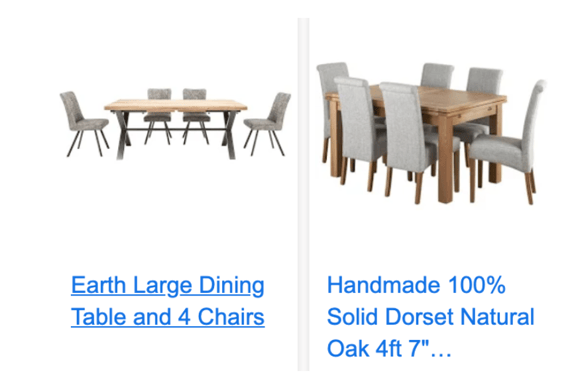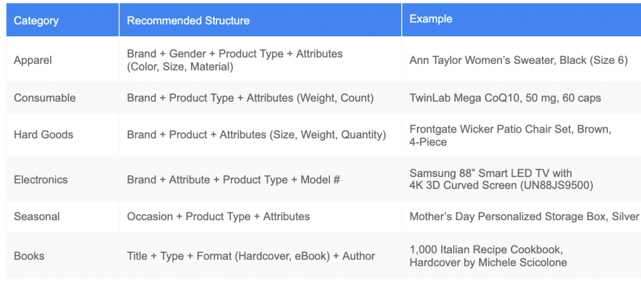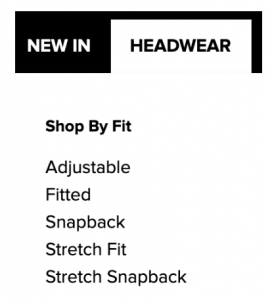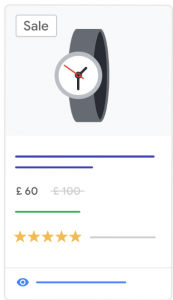An Introduction To Feeds
Most people who deal with eCommerce know that a product feed is the backbone of selling products through major search platforms. It houses all your essential product information with a range of attributes and comes in a variety of file formats, both static and dynamic. Not many know just how much weight certain product attributes can have on the success of their online business.
What if we told you that a combination of high-quality title, description and product type attributes can increase your overall impressions? Given how towards the end of 2020 Google & Microsoft opened up their shopping for additional free listings, a solid feed is now more important than ever. Here we show you a few ways you can enhance your feed to a higher level.
The Power Of A Strong Title

Be Clear & Concise:
Above are two slightly similar products, a brown dining table complete with grey chairs, think about the information you receive from a glance. The first picture just gives us the name of the product and how many chairs are included, nothing else, leading to further questions. What material is the table made from, could it be fake wood? What constitutes as large and how do you know it will fit in your kitchen?
For argument’s sake, let’s pretend the second product also includes just four chairs. Whilst still not the best example, it provides a lot more context. We know the product is handmade, crafted using 100% natural solid wood from Dorset and at 4ft 7” long, it could be an ideal fit for your kitchen.
Considering that both of these products fall into the same price range, which one would you be more inclined to click?
Best Practice For Titles:
A product title holds a huge amount of weight and should be at least 100 characters long. It’s best to front-load your title with the most relevant information first, so the user knows exactly what is being sold at first glance. Take a look at the examples below:

What might first appear as a subtle difference is actually quite a big deal. You don’t have to be Erling Haaland to know that Nike are a top manufacturer of quality football boots; brand recognition is key here. The first example flows much better off the tongue and brings the brand to attention whereas the second example sounds like someone is just spouting attributes from the product sheet.
Optimising your product titles comes with time and experience. Know your market, research search trends and understand audience intent. A/B test with different solutions, see how it affects your clickthrough rate and average CPC. Here’s a handy chart to help you along the way.

It’s All In The Description
Take Advantage Of The Character Limit:
The product description should relay the same information as your title, alongside any other product information you couldn’t otherwise fit. Here, you can expand the text to compensate for any search variants, to further increase the likelihood your product will be shown.
Much like titles, you should front-load the important information first so that a brief snippet of the description shows the audience more of the product’s key features. A typical example might start similar to the title with a smoother flow but go on to add more depth to the product, focusing on additional attributes.
On that note, don’t be afraid to make it personal, if anything it should be pushed so the potential customer buys into that particular listing. Using the example earlier, give that new householder the fuel to visualise how your reclaimed wood dining table is the perfect centrepiece to their kitchen; ignite their imagination!
Best Practice For Descriptions:
A good description should be around 500 to 800 characters long. Focus on covering different search terms as you would with SEO. Don’t stuff keywords together but instead sell your product’s story to the audience, accommodating for any search term variations. Check out the two examples below:

With the above, it feels like you’re being spoon-fed dimensions. Though the description is somewhat useful, it’s just too blunt, lacks character and has unnecessary words. In that brief snippet, ‘stained’ is repeated twice and words like ‘product details’ and ‘pictured’ use up valuable real estate that should instead be focusing on engagement.

The second example has a much smoother flow to the wording, still giving us the valuable dimensions we need but with a whole personal feel. Words like ‘exclusive’ can have a psychological effect on potential buyers, they want to be part of that ‘shabby chic’ club. Even the consistency of punctuation is pleasing to the eye.
The Value Of A Product Type
Be Your Advertiser’s Ally:
The Product Type attribute is one of the most important parts of a feed for advertising as it can make a huge difference to shopping structures. Whether you manage the ads yourself or work with an agency, this is arguably the area you should focus on optimising first. If your Product Type is extensive and uncoordinated, it’s very hard to utilise in an account. Equally, if all your products come under one bracket then it becomes difficult to segment into relative categories. There’s a balance that comes with defining a Product Type and the value it can provide, which is why it’s recommended to work together with the advertiser for the account.
Best Practice For Product Type:
The importance the Product Type can have to an account’s structure means it’s best to get it right first. Do your research, analyse your website’s structure, check your margins for similar products and come together with a solution that can synergise well when it comes to budgets and bid strategies.

In this case, the top category is Headwear, with other top options likely being Apparel or Accessories. Next, we look at the types of headwear such as caps, beanies, ushanka etc. Finally, we segment by the style with snapback, fitted or adjustable. The above breakdown, with a chevron acting as the delimiter, would look like this:
Headwear > Caps > Snapback
Headwear > Caps > Adjustable
Headwear > Beanies > Fitted
A good Product Type breakdown provides advertisers with a more strategic approach for Shopping campaign and ad group creation. If snapbacks are your biggest seller then it makes sense to give them an individual campaign, allowing those products to flourish with their own budget and bid strategy.
Whilst optimising your Product Type, you should look to populate the Google Product Category attribute, which has defined categories from a setlist. Try and align both attributes best you can, having a good Google Product Type can improve your ad relevance and allow your product to still appear when filtering.
Other Key Attributes
Product Images:
Much like the title, the image is one of the very first impressions your product has on potential customers, so it’s incredibly important to submit high standard images. If it’s of low quality, doesn’t accurately show the item being sold or has an unnecessary background, the chances are it’s less likely to be clicked.
The image size needs to be at least 100 x 100 pixels or 250 x 250 for clothing. It shouldn’t have any watermarks, even if it’s the brand’s name on the picture, or borders as this can lead to the item being disapproved. Best practice is for the product to appear on a white background with minimal or no product staging.

Product Links:
Links should go directly to the product page, without any redirects and have consistency when it comes to HTTP or HTTPS. A bad link can play a huge part in landing page experience, site speed, and even tracking getting lost. The last thing you want is to do is spend valuable resources diagnosing a tracking issue that ends up being isolated down to link integrity.
Product Reviews:
A great way to make your product stand out from the competition is to highlight the experience others have had. Hopefully, you have glowing reviews which you should absolutely brag about, especially when it can be the catalyst for someone clicking on your product. Certain platforms work with supported third-party review aggregators or have their own internal reviews system. If possible, sync up your website’s product reviews with your feed so that you have the advantage.

Promotional Sales:
Everyone loves a sale and so sale attributes are a common reason for merchants to regularly update their feed, though it should not be the sole reason. These attributes display to the potential buyer when your product is discounted and, like reviews, can be the difference between someone clicking on your product or your competitor.
Nurture Your Feed And It Will Reward:
The product feed is such an integral part of eCommerce, both for the merchant and the buyer. It’s a medium for retailers to display all their product data, whilst supplying consumers with easy access to those attributes. Through the various advertising channels, feeds can make the digital shopping experience a breeze.
To fully harness this potential, a feed needs to be looked after as you would a well-oiled machine. Concise titles, optimised descriptions and high-quality images are but a few of the ways you can influence a customer’s journey further down the sales funnel. Products can be strategically segmented into tactical campaigns, glued together through practical product type breakdowns.
Give yourself some time every month to run through your feed. Make sure your products are getting the proper attention they require so they can rise above the rest. So long as you provide your feed with accurate information and conform to best practice, the chances are that you’ll see the fruits of your labour.
Should you be in a position where you’re struggling to improve your feed or find yourself overwhelmed by the sheer amount of products you advertise, check out Mabo’s Enhanced Feed service. We optimise your feed to Google’s standard of best practice using a native platform that allows us to make efficient changes to thousands of products within seconds. Fill in the form below NOW to find out more.
Tags:
March 16, 2021